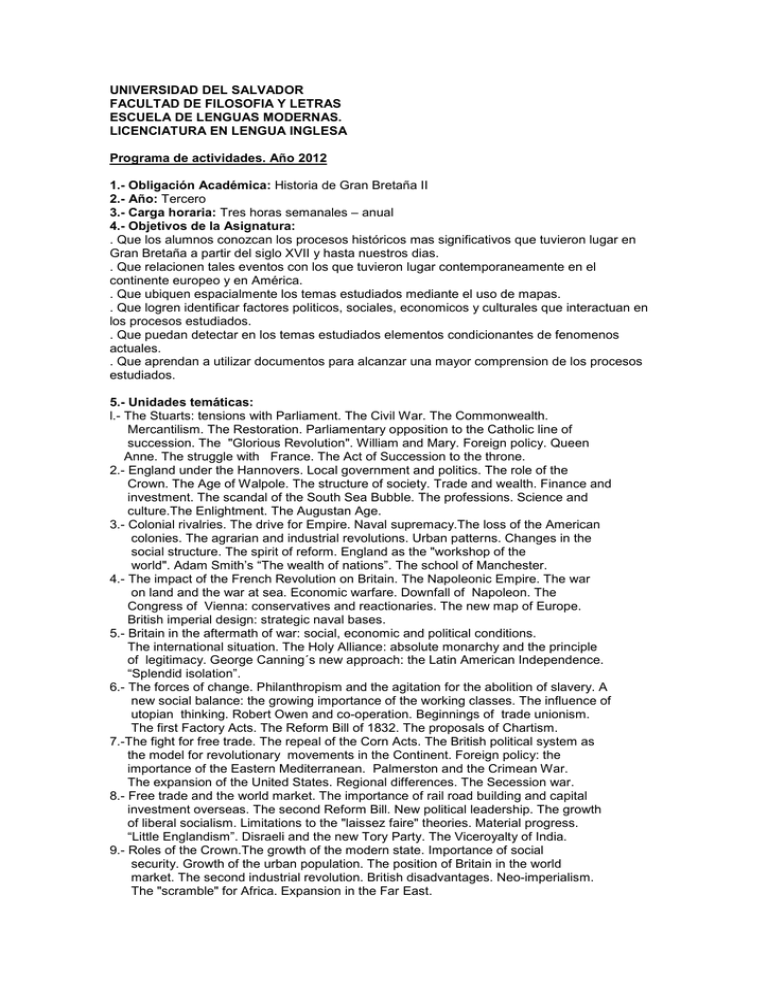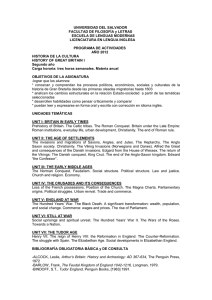Historia de Gran Bretaña II
Anuncio

UNIVERSIDAD DEL SALVADOR FACULTAD DE FILOSOFIA Y LETRAS ESCUELA DE LENGUAS MODERNAS. LICENCIATURA EN LENGUA INGLESA Programa de actividades. Año 2012 1.- Obligación Académica: Historia de Gran Bretaña II 2.- Año: Tercero 3.- Carga horaria: Tres horas semanales – anual 4.- Objetivos de la Asignatura: . Que los alumnos conozcan los procesos históricos mas significativos que tuvieron lugar en Gran Bretaña a partir del siglo XVII y hasta nuestros dias. . Que relacionen tales eventos con los que tuvieron lugar contemporaneamente en el continente europeo y en América. . Que ubiquen espacialmente los temas estudiados mediante el uso de mapas. . Que logren identificar factores politicos, sociales, economicos y culturales que interactuan en los procesos estudiados. . Que puedan detectar en los temas estudiados elementos condicionantes de fenomenos actuales. . Que aprendan a utilizar documentos para alcanzar una mayor comprension de los procesos estudiados. 5.- Unidades temáticas: l.- The Stuarts: tensions with Parliament. The Civil War. The Commonwealth. Mercantilism. The Restoration. Parliamentary opposition to the Catholic line of succession. The "Glorious Revolution". William and Mary. Foreign policy. Queen Anne. The struggle with France. The Act of Succession to the throne. 2.- England under the Hannovers. Local government and politics. The role of the Crown. The Age of Walpole. The structure of society. Trade and wealth. Finance and investment. The scandal of the South Sea Bubble. The professions. Science and culture.The Enlightment. The Augustan Age. 3.- Colonial rivalries. The drive for Empire. Naval supremacy.The loss of the American colonies. The agrarian and industrial revolutions. Urban patterns. Changes in the social structure. The spirit of reform. England as the "workshop of the world". Adam Smith’s “The wealth of nations”. The school of Manchester. 4.- The impact of the French Revolution on Britain. The Napoleonic Empire. The war on land and the war at sea. Economic warfare. Downfall of Napoleon. The Congress of Vienna: conservatives and reactionaries. The new map of Europe. British imperial design: strategic naval bases. 5.- Britain in the aftermath of war: social, economic and political conditions. The international situation. The Holy Alliance: absolute monarchy and the principle of legitimacy. George Canning´s new approach: the Latin American Independence. “Splendid isolation”. 6.- The forces of change. Philanthropism and the agitation for the abolition of slavery. A new social balance: the growing importance of the working classes. The influence of utopian thinking. Robert Owen and co-operation. Beginnings of trade unionism. The first Factory Acts. The Reform Bill of 1832. The proposals of Chartism. 7.-The fight for free trade. The repeal of the Corn Acts. The British political system as the model for revolutionary movements in the Continent. Foreign policy: the importance of the Eastern Mediterranean. Palmerston and the Crimean War. The expansion of the United States. Regional differences. The Secession war. 8.- Free trade and the world market. The importance of rail road building and capital investment overseas. The second Reform Bill. New political leadership. The growth of liberal socialism. Limitations to the "laissez faire" theories. Material progress. “Little Englandism”. Disraeli and the new Tory Party. The Viceroyalty of India. 9.- Roles of the Crown.The growth of the modern state. Importance of social security. Growth of the urban population. The position of Britain in the world market. The second industrial revolution. British disadvantages. Neo-imperialism. The "scramble" for Africa. Expansion in the Far East. 10. Drifting towards war. The issues at stake. Systems of alliances. The first world war. Strategies. The home front. The Russian revolution.The Paris conferences. Peace treaties with the defeated nations. The League of Nations. Its weaknesses. The Irish question. Nationalism and resentment. Colonial reaction: India. 11. The period between the wars. The social issues. The political growth of Labour. Unemployment and strikes. New dictatorships and old democracies. Challenge to capitalism. Fascism and Communism. Depression and world crisis. Protectionistic policies. The Ottawa Conferences. Middle Eastern policies. 12. The failure of disarmament. The policy of appeasement. The second world war. The battle of Britain. Defeat in the continent. The war at sea. The grand alliance.Conferences of the Allies' leaders. The future of Europe. Colonial twilight. Post-war Britain. The economic weakness. Social advances. 6.- Bibliografía obligatoria básica: . Morgan, Kenneth. The Oxford History of Britain. Oxford University Press. .Thomson, David. England in the XIX century. The Pelikan History of England. 8, Penguin Books. .Thomson, David. England in the XX century. Jonathan Cape. .- Bibliografía complementaria: .Ashley, Maurice. England in the XVIII century. The Pelikan History of England, 6. Penguin Books. . Adams, Robert M. The land and literature of England. A historical account. W.W.Norton & Co. 1983. .Childs, David, Britain since 1945. A political history. Routledge, 1997. .Ensor, R.C.K. England. l87O-l9l4. Oxford University Press. .Gladstone, David (ed). Edwin Chadwick, Nineteenth Century Social Reform, Routledge. 1994. .Grant Robertson, Charles. England under the Hannoverians. Methuen and Co. Ltd. London. . Lively, Jack, Lively, Adam (ed) Democracy in Britain. A reader. Blackwell. 1994. . Robson, W. Twentieth Century Britain. Oxford University Press. .Thompson, Noel and Eastwood, David (editors). The collected works of William Cobbett, Routledge, 1997. 7.- Pruebas parciales y/o monografías u otros trabajos exigidos: Esta materia se promociona con 8 (ocho) puntos. La evaluación depende de tres examenes escritos parciales y un informe oral sobre alguno de los temas que no fueron cubiertos por los parciales. 8.- Procedimientos de examen o evaluación final: Rendirán examen final aquellos alumnos que no alcancen la nota de 8 puntos requerida para la promoción. 9.- Firma del Profesor: 10.- Firma y aclaración con la aprobación del Director de Carrera y fecha: Sello de la Unidad Académica



